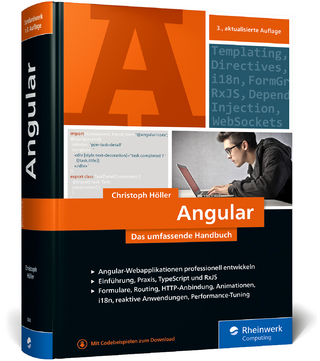
Android App Development For Dummies
For Dummies (Verlag)
978-1-119-01792-9 (ISBN)
The updated edition of the bestselling guide to Android app development If you have ambitions to build an Android app, this hands-on guide gives you everything you need to dig into the development process and turn your great idea into a reality! In this new edition of Android App Development For Dummies, you'll find easy-to-follow access to the latest programming techniques that take advantage of the new features of the Android operating system. Plus, two programs are provided: a simple program to get you started and an intermediate program that uses more advanced aspects of the Android platform.
Android mobile devices currently account for nearly 80% of mobile phone market share worldwide, making it the best platform to reach the widest possible audience. With the help of this friendly guide, developers of all stripes will quickly find out how to install the tools they need, design a good user interface, grasp the design differences between phone and tablet applications, handle user input, avoid common pitfalls, and turn a "meh" app into one that garners applause.
Create seriously cool apps for the latest Android smartphones and tablets
Adapt your existing apps for use on an Android device
Start working with programs and tools to create Android apps
Publish your apps to the Google Play Store
Whether you're a new or veteran programmer, Android App Development For Dummies will have you up and running with the ins and outs of the Android platform in no time.
Michael Burton is the Head of Mobile Engineering at Groupon and creator of the popular RoboGuice programming framework for Android. He's the author of the OpenTable, Digg, TripIt, and award winning Groupon Android apps, and has addressed conferences around the world.
Introduction 1
About This Book 1
Conventions Used in This Book 2
Foolish Assumptions 2
How This Book Is Organized 3
Part I: Getting Started with Your First Android Application 3
Part II: Building and Publishing Your First Android Application 3
Part III: Creating a Feature-Rich Application 3
Part IV: Android Is More than Phones 3
Part V: The Part of Tens 4
Icons Used in This Book 4
Beyond the Book 4
Part I: Getting Started with Your First Android Application 7
Chapter 1: Developing Spectacular Android Applications 9
Why Develop for Android? 9
Android Development Basics 12
Hardware Tools 20
Software Tools 22
Chapter 2: Prepping Your Development Headquarters 25
Developing the Android Developer Inside You 25
Assembling Your Toolkit 26
Tuning Up Your Hardware 30
Installing and Configuring Your Support Tools 31
Installing Android Studio 31
Installing Java 7 33
Adding SDK Packages 33
Navigating the Android SDK 34
Specifying Android Platforms 34
Using SDK Tools for Everyday Development 35
Part II: Building and Publishing Your First Application 39
Chapter 3: Your First Android Project 41
Starting a New Project in Android Studio 41
Responding to Errors 45
Setting Up an Emulator 47
Running the Hello Android App 49
Understanding Project Structure 52
Chapter 4: Creating the User Interface 65
Creating the Silent Mode Toggle Application 65
Laying Out the Application 67
Adding an Image to Your Application 71
Creating a Launcher Icon for the Application 75
Previewing the Application in the Visual Designer 77
Chapter 5: Coding Your Application 79
Understanding Activities and the Activity Lifecycle 79
Creating Your First Activity 84
Working with the Android Framework Classes 88
Installing Your Application 92
Material Design 96
Uh-Oh! (Responding to Errors) 98
Thinking Beyond the Application Boundaries 103
Chapter 6: Understanding Android Resources 107
Understanding Resources 107
Working with Resources 110
Different Strokes for Different Folks: Using Resource Qualifier Directories 114
Chapter 7: Turning Your Application into an App Widget 119
Working with App Widgets in Android 120
Working with Intents and Pending Intents 122
Creating the App Widget 127
Placing Your Widget on the Home Screen 137
Chapter 8: Publishing Your App to the Google Play Store 139
Creating a Distributable File 139
Creating a Google Play Developer Profile 145
Pricing Your Application 148
Getting Screen Shots for Your Application 149
Uploading Your Application to the Google Play Store 150
Watching the Number of Installs Soar 153
Part III: Creating a Feature-Rich Application 155
Chapter 9: Designing the Tasks Application 157
Reviewing the Basic Requirements 157
Creating the Application’s Screens 159
Chapter 10: Creating the Task Detail Page 181
Creating the TaskEditActivity 181
Linking the List View to the Edit View 183
Creating the TaskEditFragment 185
You Put the Fragment in the Activity and Shake It All Up 193
Updating the Styles 194
A Special Bonus 196
Chapter 11: Going a la Carte with Your Menu 199
Understanding Options and Context Menus 199
Creating Your First Menu 200
Creating a Long-Press Action 207
Chapter 12: Handling User Input 211
Creating the User Input Interface 211
Getting Choosy with Dates and Times 214
Creating an Alert Dialog 225
Validating Input 230
Chapter 13: Getting Persistent with Data Storage 233
Finding Places to Put Data 233
Understanding How the SQLite ContentProvider Works 236
Creating Your Application’s SQLite Database 237
Using ContentProvider URIs 241
Dealing with CRUD 244
Implementing the Save Button 250
Implementing the List View 253
Reading Data into the Edit Page 261
Chapter 14: Reminding the User 265
Seeing Why You Need AlarmManager 266
Asking the User for Permission 266
Waking Up a Process with AlarmManager 267
Updating a Notification 274
Clearing a Notification 274
Rebooting Devices 275
Chapter 15: Working with Android Preferences 279
Understanding the Android Preferences Framework 280
Understanding the Preference Fragment Class 280
Creating Your Preferences Screen 283
Working with the Preference Fragment Class 285
Working with Preferences in Your Activities at Runtime 289
Part IV: Android Is More than Phones 293
Chapter 16: Developing for Tablets 295
Considering the Differences between Phones and Tablets 295
Tweaking the Tasks App for Tablets 296
Configuring a Tablet Emulator 301
Creating a New Product Flavor 302
Creating an AndroidManifest for Phones 303
Creating an AndroidManifest for Tablets 305
Making the TaskListAndEditorActivity for Tablets 307
Building the Tablet App 310
Adding the App Callbacks 312
One More Thing 313
Chapter 17: Supporting Older Versions of Android 315
Understanding AppCompat 316
Updating the build File 317
Adding the Toolbar 318
Using the AppCompat Theme 319
Testing Your App 321
Working with Right-to-Left Languages 323
Fixing the Add Task Menu 325
Fixing the Window Options 326
Using Newer APIs 329
Using Android Lint 330
Chapter 18: Wearing the Tasks App 333
Preparing Your Development Environment 335
Creating a New Wear App 339
Publishing the Data from Your Phone 350
Running the App without Android Studio 355
Packaging the App 356
What’s Next? 356
Chapter 19: Look Ma, I’m on TV! 357
Understanding Guidelines for Building TV Apps 357
Building and Manifesting Changes 358
Adding the BrowseActivity 360
Creating the TV Browse Fragment 361
Creating the CardPresenter 368
Running Your App 371
Adding and Editing Items 372
Creating Backgrounds 373
Creating More Filters 375
Chapter 20: Moving beyond Google 381
Working around Google Features 381
Setting Up the Fire SDK 382
Setting Up Your Fire or Emulator 383
Publishing to Amazon Appstore for Android 386
Part V: The Part of Tens 393
Chapter 21: Ten Free Sample Applications and SDKs 395
Android Samples 395
The Google I/O App 396
K‐9 Mail 396
GitHub Android App 396
Facebook SDK for Android 396
Notepad Tutorial 397
U+2020 397
Lollipop Easter Egg 397
Android Bootstrap 398
The AOSP 398
Chapter 22: Ten Tools to Simplify Your Development Life 399
Android Lint 399
Android Systrace 399
RoboGuice and Dagger 400
Translator Toolkit 400
Hierarchy Viewer 401
UI/Application Exerciser Monkey 401
Git and GitHub 401
Picasso and OkHttp 402
Memory Analyzer Tool 402
Travis‐ci 402
Index 403
| Sprache | englisch |
|---|---|
| Maße | 188 x 234 mm |
| Gewicht | 567 g |
| Themenwelt | Mathematik / Informatik ► Informatik ► Programmiersprachen / -werkzeuge |
| Informatik ► Software Entwicklung ► Mobile- / App-Entwicklung | |
| Informatik ► Weitere Themen ► Smartphones / Tablets | |
| ISBN-10 | 1-119-01792-0 / 1119017920 |
| ISBN-13 | 978-1-119-01792-9 / 9781119017929 |
| Zustand | Neuware |
| Informationen gemäß Produktsicherheitsverordnung (GPSR) | |
| Haben Sie eine Frage zum Produkt? |
aus dem Bereich


